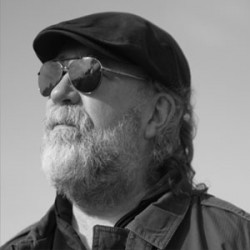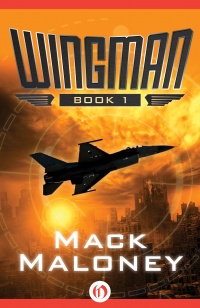
Guest Post by Mack Maloney
First appearing in 1987, the Wingman series follows the adventures of Hawk Hunter, the best fighter pilot who ever lived, as he tries to reunite a fractured America in a post-apocalyptic world. The sixteen original books sold more than a million copies over the next ten years and, recently revived as e-books, I’m happy to report they’re selling very well again.
The series is known for two things: larger-than-life characters and intense battle scenes. In fact, many readers have asked me over the years how I was able to put together the multitude of aerial dogfights that dominate the books.
Actually, I have two people to thank for this: George Lucas and my father.
I was in film school in Boston when Star Wars first came out. It was a dream come true for me, a huge science fiction fan, because here was an SF film that wasn’t automatically given B-movie status. It was big and bold and made with a substantial budget. Something to be taken seriously.
I went to one of the first screenings, and while I enjoyed the movie immensely, what struck me most was how the space battle scenes were edited together. There was something almost familiar about them. Only later did I learn that George Lucas had studied films of World War I dogfights to get the motion of his space fighters just right. In fact, in an early screening of the film for Fox executives, Lucas had cut in actual World War I dogfight footage where the space battles were supposed to be, just so the money men could get an idea of what he was up to. All this stayed in my head.
 Ten years later, when I began writing the first Wingman book, I faced the task of trying to describe a jet dogfight in words – not an easy thing to do because, in theory at least, everything is moving so damn fast, a battle between jets is usually over in a split second. That’s when all this Star Wars experience came streaming back. I watched the movie on tape and appreciated once again the secret of how Lucas assembled his aerial battle scenes.
Ten years later, when I began writing the first Wingman book, I faced the task of trying to describe a jet dogfight in words – not an easy thing to do because, in theory at least, everything is moving so damn fast, a battle between jets is usually over in a split second. That’s when all this Star Wars experience came streaming back. I watched the movie on tape and appreciated once again the secret of how Lucas assembled his aerial battle scenes.
Just like the way World War I biplanes flew in dogfights, Lucas had his space fighters twisting, turning, climbing, and diving as if in some kind of chaotic ballet moving in hyperdrive. I kept this in mind when writing Wingman’s first aerial combat scenes. Though everything is, in fact, going at supersonic speeds, the emphasis should always be on how aircraft can and do move. Suspend time in a way, and describe the deadly gracefulness of jet-powered combat aircraft.
I also had to figure out the best way to present the overall battles themselves. Every battle has a beginning, a middle, and an end – but it’s hard to dream up all three elements out of thin air and make them seem credible.
This is where my father comes in. He was a veteran of World War II, having spent four years in the South Pacific on a ship that was subsequently sunk by the Japanese. He became an avid reader of military history after the war, and his history books were always around the house when I was growing up. Even before I was able to read, I used to look at their pictures, and as I grew older I read them over and over, cover to cover. By the time I was in the third grade, I knew what Guadalcanal, the Battle of Midway, and Iwo Jima were all about.
Flash forward again to my writing the first Wingman book. I knew I’d have to manufacture at least a handful of major battles, along with their tactics and strategies – again, hard to do out of whole cloth. But luckily I was able to fall back on my father’s history books, many of which I’d kept after he’d passed away.
Whenever I needed specifics for a huge battle, I’d recreate it based on an actual battle from World War II. I’d duplicate the same strategy, tactics, and timeline, but would usually substitute jet fighters and bombers for ships and tanks. Then, because as they say, “Writing is rewriting,” I’d put these recreated battle scenes through many rigorous edits until they were practically unrecognizable from the actual historic battles. But they served as templates for what I wanted.
All this made that first Wingman book a lot easier to write, and so I carried on the practice for the next fifteen books.
Like a magician, it’s probably best that a writer not reveal his secrets. But in this case, I’ll gladly make the exception if it allows me to finally tip my cap to George Lucas – and my dad.
Mack Maloney is the author of numerous fiction series, including Wingman, ChopperOps, Starhawk, and Pirate Hunters, as well as UFOs in Wartime – What They Didn’t Want You to Know. He is the host of a national radio show, Mack Maloney’s Military X-Files.
Check out more heart-pumping battle-laden fiction from Open Road Media:
https://www.openroadmedia.com/summerbattlestars










